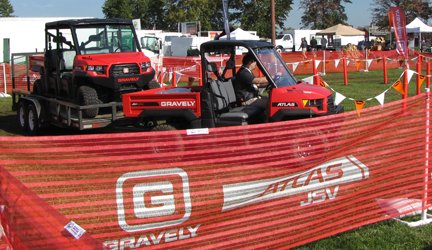New Job Site Vehicle Works to Improve
Power, Performance, Productivity
by Mike Martin
In the outdoor demonstration area at last week’s GIE+Expo in Lousiville, landscapers, hardscapers and other equipment owners had the opportunity to give Gravely’s new “JSV” – Job Site Vehicle – a quick turn around a track to test its handling, and then test its muscle by pulling a trailer and 1-ton load around another short track. The objective, according to JW Washington, regional manager for Ariens Company, was to let potential users see why the company went bigger and stronger with its entry into the growing ‘work horse’ utility vehicle market.
“We conducted a lot of VOC – Voice of the Customer – research in the commercial landscaping, production agriculture and government sectors to find out what people liked and what they did not like about the various utility vehicles available today. Their input and our research, if you look at a grid with “Traditional” in the upper left quadrant and “Performance” in the lower right quadrant, pointed us to the upper right area. We’ve taken that traditional work aspect and then designed more performance features, job site productivity features really, into the Atlas. It gives us some key points of difference,” he emphasizes.
The Atlas JSV was co-engineered with Polaris (makers of the Brutus UTV) and was on the drawing board and in various stages of testing for two years. “Our whole focus was to help our customers get more work done and do it faster and easier on the job site,” Washington says.
You can find more information on the Atlas in our New Products section, and on the company’s website. But Washington touched on some of the highlights. “You can move three people or six people all around the job site, depending on which Atlas you choose. You can move them at 35 miles per hour. You can, literally, tow a ton. You can carry 1250 pounds of payload.
“On the 6-passenger model, think about being able to move the people and 18 cu ft of soil, gravel or other material. We have under-seat storage for tools. There are two 12-volt receptacles and you can get 46 amps on the gasoline model and 110 amps or more on the diesel,” he says. “They’re built to help our end users be more productive.”
 |
| Attendees could test the new vehicle's towing power and agility, including the 3000 (3-passenger) model towing a trailer carrying the company's JSV-6000 crew cab. |
For rental centers, safety and ease-of-use are key features. He points out that the Atlas has 3-point seatbelts for each passengers, full ROP, integrated parking brake (users can’t ‘drive through’ the brake), plus horn, strobe lights and other related features to keep users safe. “If an owner wants the vehicle to do less than 35 miles per hour, you can key it back,” he adds. There’s adjustable steering, head rests and De Dion suspension that helps balance the load so there’s less pitch and sway, particularly when the vehicle is carrying its full capacity. They’ve also put more distance between the brake and gas pedals “so the driver has plenty of room when wearing work boots.”
Early interest in the vehicles has been coming from larg, commercial landscapers, but rental centers are also a key potential user, he says, particularly the mid-range, five- to 20-location companies. “We think that any rental center serving a blend of contractors – because productivity is important to all of them – will see value in a true job site vehicle,” Washington says.









